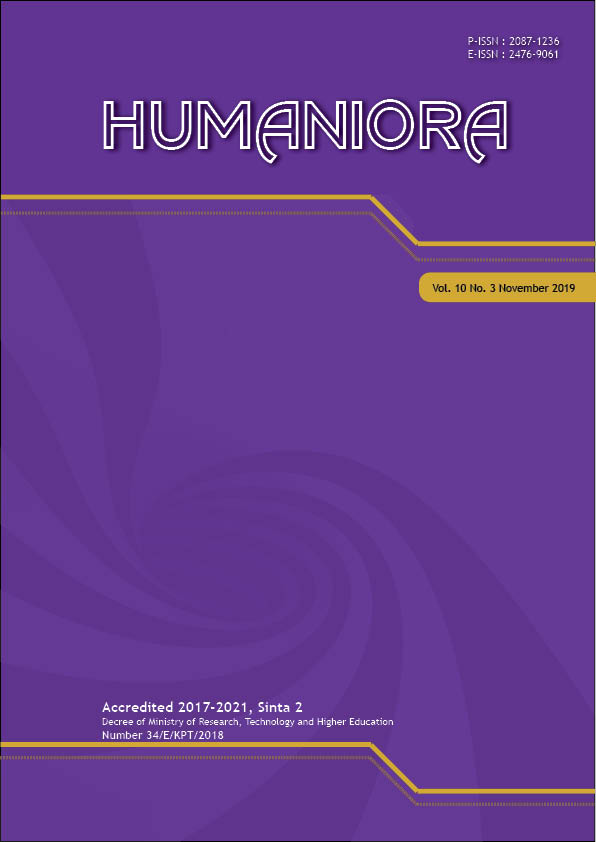Traditional and Conventional Social Communication Processes for Increasing Tolerance and Harmonization of Inter-Religious Communities in Indonesia
DOI:
https://doi.org/10.21512/humaniora.v10i3.6021Keywords:
social communication, tolerance and harmonization, inter-religious, communitiesAbstract
This research focused on the social communication process for increasing tolerance and harmonization of inter-religious communities in Indonesia. This research method used the case study design. Research data of this case study were collected through observations and in-depth interviews. The results indicate that the process of social communication between religions takes place dynamically in the community. It involves mutual interactions and respect for each other according to social norms and values adopted by the local community. By interacting and respecting each other, the social life of the community can be maintained to be harmonious, safe, comfortable, full of tolerance and harmony, and coexist in religious, cultural, ethnic, racial, and ethnic diversity. Based on research findings, all can be done through the social communication process for increasing tolerance and harmonization of social life among religious communities in Indonesia that the process of social communication is directly referred to as traditional and conventional communication.
References
Courtis, M., & Cayton, C. (2018). Issues concerning religious tolerance and diversity. Oregon: Portland Community College. Retrieved on September 2nd, 2019 from https://www.pcc.edu/illumination/wp-content/uploads/sites/54/2018/05/religious-bias-curriculum.pdf.
Elly, M., & Setiadi, U. K. (2011). Pengantar sosiologi: Pemahaman fakta dan gejala permasalahan sosial; Teori, aplikasi, dan pemecahannya. Jakarta: Kencana.
Fadzil, A. (2011). Religious tolerance in Islam: Theories, practices, and Malaysia’s experiences as a multi-racial society. Journal of Islam in Asia, 3, 345-360.
Gräf, M. (1995). Aspects of traditional communication. Retrieved on May 16th, 2019 from http://www.cameco.org/mediaforum_pdf/ib02932.pdf.
Hook, D. (2011). The social psychology of communication. United Kingdom: Palgrave Macmillan.
Macionis, J. J. (2017). Sociology (Sixteenth Edition). USA: Pearson Education.
Neuman, W. L. (2003). Social research methods: Qualitative and quantitative approaches. Boston: Pearson Education.
Raji, A., Abdullateef, T. K., Araba-Yusuf, I., & Festus, O. (2015). Religious tolerance as a means for peaceful co-existence in Nigeria. Annals of Clinical Psychiatry, 1-16.
Redse, A. (2007). Freedom of religion, religious tolerance, and the future of Christian mission in the light of Samuel P. Huntington’s thesis on the clash of civilizations and the remaking of the world order. Retrieved on September 2nd, 2019 from https://www.egede.no/sites/default/files/dokumenter/pdf/NTM_2007_4_Redse.pdf.
Sutaryo. (2005). Sosiologi komunikasi, perspektif teoritik. Yogyakarta: Arti Bumi Intaran.
Vurmo, G. (2018). Religious tolerance in Albania. Albania: UNDP.
Yin, R. K. (2008). Case study research: Design and methods (4th Ed.). London:SAGE Publications.
Zuo’an, W. (2013). Religious harmony: A fresh concept in the age of globalization. Procedia - Social and Behavioral Sciences, 77, 210-213.
Downloads
Published
How to Cite
Issue
Section
License
Authors who publish with this journal agree to the following terms:
a. Authors retain copyright and grant the journal right of first publication with the work simultaneously licensed under a Creative Commons Attribution License - Share Alike that allows others to share the work with an acknowledgment of the work's authorship and initial publication in this journal.
b. Authors are able to enter into separate, additional contractual arrangements for the non-exclusive distribution of the journal's published version of the work (e.g., post it to an institutional repository or publish it in a book), with an acknowledgment of its initial publication in this journal.
c. Authors are permitted and encouraged to post their work online (e.g., in institutional repositories or on their website) prior to and during the submission process, as it can lead to productive exchanges, as well as earlier and greater citation of published work.
USER RIGHTS
All articles published Open Access will be immediately and permanently free for everyone to read and download. We are continuously working with our author communities to select the best choice of license options, currently being defined for this journal as follows: Creative Commons Attribution-Share Alike (CC BY-SA)




















